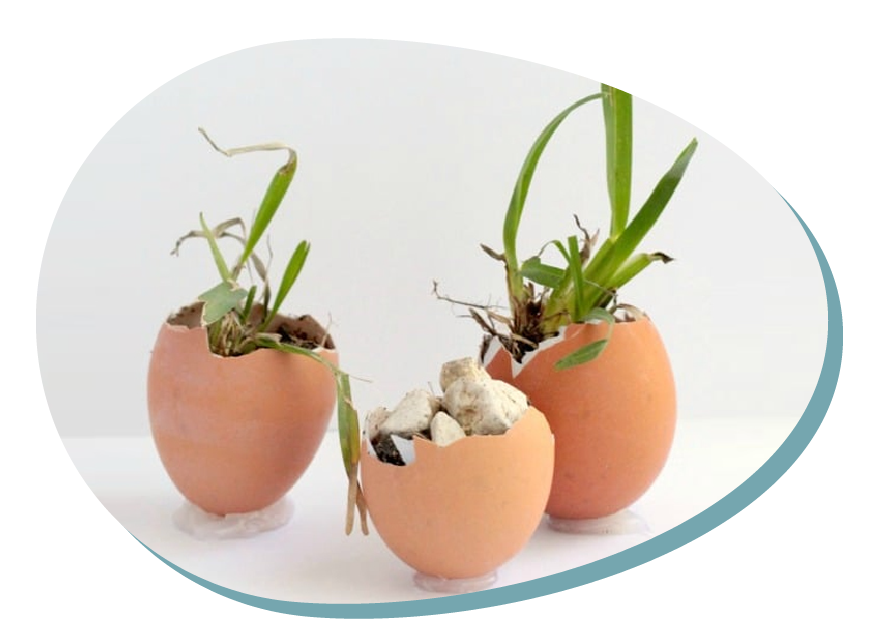A plant in an egg shell
Type of resource: website, guideliness
Web address https://www.steamsational.com/egg-shell-garden-science/
Language: English
Description
Experiment with egg shells to see how a plant grows differently depending on the conditions of the environment.
Scientific concept introduced
Growth, seeds, watering.
Creative and critical thinking
–
Mathematical reasoning
To measure the amount of soil we will need for each egg.
To develop the ability to observe and discover.
Scientific thinking
To ask questions.
To conduct a research and gather the information in order to see how the different conditions affect the growth of the plants.
Learning how to learn
Motivation to learn and engage.
Additional
Use of hand-eye coordination.
To develop an aesthetic sense.
A plant in an egg shell
Overall aims
To develop the ability to observe and discover
To strengthen the research attitude of children
To conduct a research
To improve children’s problem-solving (take initiative)
To create the learning opportunity for explaining the concepts of soil, growth, and parts of the plants
Vocabulary – keywords should be understood
Egg, egg shell, seed, to grow, growth, sprouts, roots, soil, dirt, magnifying glass, wax paper, hot glue, to stand, light, sun, to peel, to sprinkle, to dampen.
Expected learning outcomes (operational aims)
To follow the steps
To explain the concepts of seeds, soil, growth, plant’s parts
To measure or calculate the days the plants take to grow
To discover how plants grow and how to help the process
STEM skills – to which the learning unit is related to
CORE STEM SKILLS
● Asking questions.
● Analysing and solving problems.
● Designing experiments.
● Conducting research.
● Drawing conclusions based on results.
● Motivation to learn and engage.
● Self-discipline and self-regulated learning (cognitive autonomy).
ADDITIONAL SKILLS
Sharing ideas
Following the safety rules and discipline
Sharing responsibility for a task
Taking common decisions
Basic literacy- listening with comprehension
Teaching methodologies/activity outline
1- Remove the egg from the shell
Crack open the skinny end of the egg. Rinse and dry the egg shells.
Scrambled eggs can be made with the centers.
2- Make stands for the egg shells: place a glob of hot glue onto a piece of wax paper. Stick the egg shell into the glue before it is dry.
3- When the glue dries, carefully peel the egg off of the wax paper. It should stand on its own.
4- Put dirt inside the eggs and sprinkle with seeds. Dampen the seeds and place in a sunny spot (or in different spots if you are comparing growing conditions)
5- Wait for seeds to sprout. The sprouts should begin to be seen within a week.
6- After a few weeks, the sprouts will be growing nicely.
7- Examine them with a magnifying glass. Look at the sprouts and the roots and compare textures, and discuss why plants have these parts and what they use them for.
Note: Seeds will grow differently in various conditions. Try placing one egg shell on the sun, one in partial sun, one indoors, and one in the dark. You can also compare soil types, or see which seeds grow best inside an egg shell. Which seeds grow best and in which conditions?
Assessment of learning
Initial evaluation
– Get to know the previous knowledge they could know about the same theme.
Continued evaluation
– Progressively acquire basic habits of autonomy in everyday actions, to act safely and effectively.
– Observe and explore the immediate, natural and physical environment, with an attitude of curiosity and respect and gradually participate in social and cultural activities.
– Participate in the activity, through movement, assimilating sensations related to touch and time and with a progressive understanding of the necessity of some norms.
– Use the oral language, gesture and images to express ideas, desires, feelings and emotions; Listen and participate actively in regular situations.
Conversation and learning with the use of non-discriminatory language, and with attitude of respect towards other cultures and different languages.
– Manifesting the necessary abilities to be able to listen, observe, interpret and create in the different languages: verbal, body, plastic, musical, and mathematical audio-visual, and incorporate the introduction to technological instruments (ICT).
Final evaluation
To evaluate the learning objectives, use the chart in which the more important elements will be highlighted
Equipment and materials to be used in learning unit (tools, ingredients etc)
● Egg shells
● Grass seeds (or other seeds of small plants)
● Soil (potting soil, or dirt)
● Hot glue gun and glue sticks
● Wax paper
● Magnifying glass
Kind of setting
Preschool room, garden
References – source
A plant in an egg shell
1. Usefulness for STEM education – integrating content of different disciplines
Cross-curricular character of the resource

The range of S-T-E-M subjects included

The presentation of possibilities of including artistic activities (STEAM approach)

2. Expected learning outcomes
Consistency (links) with preschool core curriculum

Communicativeness of description

3. Methodology of teaching
Clarity, communicativeness of instructions for teachers

Meaningful learning – using practical life problems

Original idea

The level of ease in implementing the methodology to preschool age children

The level of ease in preparing necessary ingredients, materials and equipment needed

4. Sustainability
Ecological characteristics of materials/ results

Supporting healthy eating habits

Relation with local traditions of cooking (using local products)

Low ecological footprint

Possibilities of inclusion (respecting cultural diversity and food intolerances)

5. Class management
Using differentiated forms of work – individual, team work etc.

Individual work

Team work

Whole group
6. Time management

Short activity (10-15 minutes)

Medium activity (20-30 minutes)

Long activity (1 hour or more)

Very long activity (1 day or more)
PDF: https://www.printfriendly.com/p/g/avE7EE

